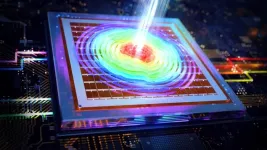Scientists at UMass Amherst engineer plant-based method of 'precious' mineral mining
Their research manipulates the superplant Camelina sativa to accumulate nickel, provide oil for biofuel and clean contaminated soil
2025-01-27
(Press-News.org) January 27, 2025
Scientists at UMass Amherst Engineer Plant-based method of Precious Mineral Mining
Their research manipulates the superplant Camelina sativa to accumulate nickel, provide oil for biofuel and clean contaminated soil
AMHERST, Mass. — As unassuming plant—considered a noxious weed by some—may be the key to fueling a green economy in the U.S. University of Massachusetts Amherst scientists are working with Camelina sativa, a member of the mustard family, to enhance a trio of the plant’s superpowers: absorbing trace amounts of the critical mineral nickel from the soil and improving the soil’s fertility, storing that nickel in its biomass where it can be harvested and extracted for use, and, in its seeds, providing a rich source of the oil needed for biofuels.
While we may know what technology we need to transition the U.S. to a green economy, having the raw materials to do so is another matter entirely, especially when it comes to the critical materials and minerals that are the backbone of energy-efficient batteries and electrical vehicles. All plants absorb nutrients and minerals from the soil and incorporate them into their leaves and stems, but there are some, known as “hyperaccumulators,” that have evolved the ability to accumulate specific minerals in staggering quantities.
These hyperaccumulators are the specialty of Om Parkash Dhankher, professor of molecular biology and phytoremediation in UMass Amherst’s Stockbridge School of Agriculture, who has spent the last few decades studying how plants can be used to absorb toxic elements from the soil, cleaning it through a technique called phytoremediation.
It’s only a short step from phytoremediation to phytomining, which is when the hyperaccumulated mineral is then harvested from the plant for use in industrial or manufacturing applications.
One plant in particular, Odontarrhena (formerly Alyssum murale), is known to hyperaccumulate nickel, a critical electrical component that is in short supply in the U.S. There is currently only one company actively mining nickel in the states in a conventional mine, despite the fact that nearly one million acres contain trace amounts of nickel in the topsoil. The vast majority of nickel comes from Indonesia and is processed elsewhere in the world. Because nickel is a low-level toxin, the soils in which it occurs are typically barren.
While it might seem that growing Alyssum in the U.S. would be an obvious fix — up to 3% of the plant’s biomass can be made up of nickel — Dhankher notes that it is slow-growing, low biomass, difficult to manage and takes a comparatively long nine months until it is ready to harvest. The upshot is that it takes an awful lot of Alyssum to yield a useful amount of nickel, and Alyssum is also considered an invasive species.
None of this is true of Camelina sativa, a plant that is already in wide cultivation in the U.S. Two to three crops of Camelina can be grown and harvested in the time it takes to grow a single crop of Alyssum, and its seeds are a rich source of the oil that is a core ingredient in biofuels. Thanks to Dhankher’s previous research, we now know how to enhance Camelina’s oil-producing capabilities.
“Our idea” says Dhankher, “is to determine which genes and proteins are responsible for Alyssum’s nickel hyperaccumulation, then re-engineer Camelina so that it, too, can hyperaccumulate nickel. We also want to determine which soil amendments will optimize the engineered Camelina’s ability to pull even more nickel from the soil.”
“The availability of nickel in the soil available for plant-uptake is determined by soil factors and soil health,” says Dhankher’s co-investigator, Baoshan Xing, Distinguished Professor and director of the Stockbridge School at UMass Amherst. “We will characterize these nickel-bearing soils in detail and improve the soil conditions accordingly to enhance the availability of nickel and improve the plant’s uptake of the element for hyperaccumulation.”
The result would be a minimally invasive way to extract trace amounts of nickel, returning the soil’s arability, and providing increased stocks for biofuel, all without relying on a complex and ever-evolving geopolitical situation.
“We believe that there is currently enough nickel in the barren soil in the U.S. to supply us for 50 years of phytomining,” says Dhankher. “We won’t be able to supply all of the nickel the economy needs,” he adds, “but our method could account for 20 to 30 percent of the projected demand.”
Dhankher and Xing have been awarded $1,297,055 by the U.S. Department of Energy’s Advanced Research Project’s agency to develop this new strain of nickel-loving Camelina.
“As we know, we are in the era of renewable energy,” says Dhankher. “Conventional mining in monumentally destructive, but phytomining can give us a sustainable, domestic supply of nickel to help fuel the green transition.”
A media kit, with images and all credit and caption info is available here.
Contacts: Om Parkash Dhankher, parkash@umass.edu
Daegan Miller, drmiller@umass.edu
END
[Attachments] See images for this press release:

ELSE PRESS RELEASES FROM THIS DATE:
2025-01-27
The subject of when early hominins, closely related ancestors to humans, first left Africa to begin their slow dispersal across the globe is a matter of ongoing discussion among anthropologists. The general consensus has been that hominins were present in Eurasia at least 1.8 million years ago, but some ephemeral traces of hominins have hinted at an earlier presence. New evidence by an international team of researchers now pushes that date back to almost 2 million years ago.
This evidence for hominins in Eurasia earlier than ...
2025-01-27
In an international effort, researchers at Western University, the University of Maryland School of Dentistry (UMSOD) and Neuroscience Research Australia (NeuRA) uncovered how specific patterns in brain activity can predict an individual’s sensitivity to pain, expanding opportunities for improved pain management strategies.
The new study was published Jan. 27 in JAMA Neurology. It found the combination of two biomarkers in the brain – corticomotor excitability (CME), excitability in the region of the brain that controls movement, and peak alpha frequency (PAF), a neural marker associated with cognitive performance – can accurately and reliably distinguish high- ...
2025-01-27
ITHACA, N.Y. – In the same way that terrestrial life evolved from ocean swimmers to land walkers, soft robots are progressing, too, thanks to recent Cornell University research in battery development and design.
A modular worm robot and jellyfish demonstrate the benefits of “embodied energy” – an approach that incorporates power sources into the body of a machine, to reduce its weight and cost.
The worm and jellyfish are direct descendants of an aqueous soft robot, inspired by a lionfish and unveiled in 2019, that could store energy and power its applications via a circulating hydraulic fluid – i.e., “robot blood.” Similar blood sustains ...
2025-01-27
Hebrew SeniorLife, New England’s largest nonprofit provider of senior health care and living communities and the only senior care organization affiliated with Harvard Medical School, announces that its Deanna and Sidney Wolk Center for Memory Health has been recognized by the Institute of Healthcare Improvement (IHI) as an Age-Friendly Health System, level 2, Committed to Care Excellence.
To qualify as an Age-Friendly Health System, level 2, the Wolk Center, which provides comprehensive outpatient care related to brain health, cognitive and behavioral problems, and memory loss, whether due to Alzheimer’s disease, other dementias, or other neurological or psychiatric ...
2025-01-27
Absorbing layers have been fundamental to advancements in technologies like energy harvesting, stealth systems, and communication networks. These absorbers efficiently capture electromagnetic waves across broad frequency ranges, enabling the development of sustainable, self-powered devices such as remote sensors and internet of things (IoT) systems. In addition to energy applications, these layers are pivotal in stealth technology, where they minimize radar visibility and enhance the performance of aircraft and naval systems. They also play a crucial role in improving communication networks by reducing ...
2025-01-27
ITHACA, N.Y. – While floating solar – the emerging practice of putting solar panels on bodies of water – is promising in its efficiency and its potential to spare agricultural and conservation lands, a new experiment finds environmental trade-offs.
In the first manipulative field study examining the environmental impacts of floating solar, published in Environmental Science and Technology, researchers found that floating solar panels increased greenhouse gas emissions on small ponds by nearly 27%.
“There ...
2025-01-27
GRAND RAPIDS, Mich. (Jan. 27, 2025) — A person’s lifetime risk for cancer may begin before they are even born, reports a paradigm-shifting study by Van Andel Institute scientists.
The findings, published in Nature Cancer, identified two distinct epigenetic states that arise during development and are linked to cancer risk. One of these states is associated with a lower lifetime risk while the other is associated with a higher lifetime risk.
If cancer does develop in the lower risk state, it ...
2025-01-27
On the barrier islands of Miami, 35 skyscrapers – including Trump Tower III - have sunk as much as eight centimeters, or three inches, into the ground since 2016, and researchers from the University of Houston have played a pivotal role in uncovering the reason why – urban development.
The findings, published in Earth and Space Science, reveal alarming rates of subsidence – or land sinking – in coastal structures between 2016 and 2023.
According to the report, "About half of the subsiding structures are younger than 2014 and at the majority of them subsidence decays with ...
2025-01-27
Kun Sun, Professor, Information Sciences and Technology, Center for Secure Information Systems, College of Engineering and Computing (CEC), received funding for: “CyberCorps Scholarship for Service: EAGLE: Empowering American Government Leadership in Cybersecurity through Education.”
Due to the proliferation of cyber-attacks, the ...
2025-01-27
Relapse is common when someone is trying to quit, regardless of whether they’re giving up opioids or alcohol or cigarettes.
To better inform treatment, researchers with the Fralin Biomedical Research Institute at VTC’s Addiction Recovery Research Center wanted to better understand how the experience of quitting differed across substances.
“When we talk about intervention for addiction, we know that we are far from the ideal model of treatment,” said Rafaela Fontes, a research scientist at the Fralin Biomedical Research Institute and first author on the study, “Beyond ...
LAST 30 PRESS RELEASES:
[Press-News.org] Scientists at UMass Amherst engineer plant-based method of 'precious' mineral mining
Their research manipulates the superplant Camelina sativa to accumulate nickel, provide oil for biofuel and clean contaminated soil






